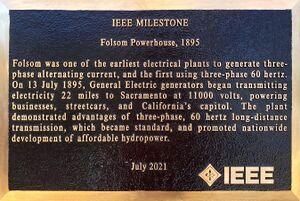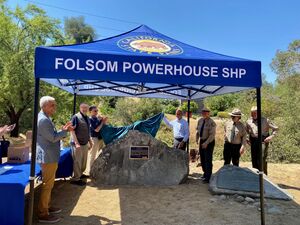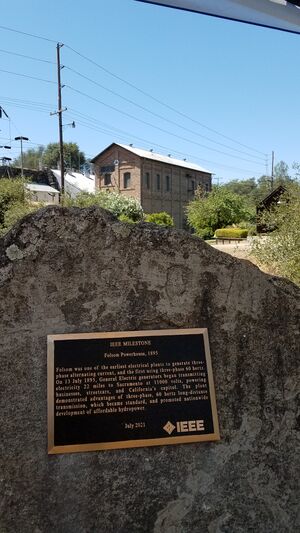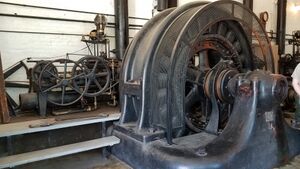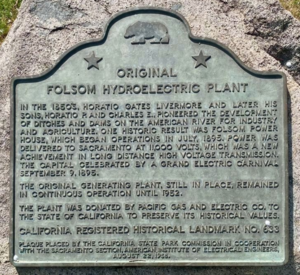Milestones:Folsom Powerhouse, 1895
- Date Dedicated
- 2021/07/13
- Dedication #
- 218
- Location
- Folsom, CA
- IEEE Regions
- 6
- IEEE sections
- Sacramento Valley
- Achievement date range
- 1895
Title
Folsom Powerhouse, 1895
Citation
Folsom was one of the earliest electrical plants to generate three-phase alternating current, and the first using three-phase 60 hertz. On 13 July 1895, General Electric generators began transmitting electricity 22 miles to Sacramento at 11000 volts, powering businesses, streetcars, and California's capitol. The plant demonstrated advantages of three-phase, 60 hertz long-distance transmission, which became standard, and promoted nationwide development of affordable hydropower.
Street address(es) and GPS coordinates of the Milestone Plaque Sites
9980 Greenback Lane, Folsom, CA 95630 US, (GPS: 38.5642041, -121.7366333)
Details of the physical location of the plaque
- The IEEE bronze plaque is installed on a granite boulder.
- Installed on a much shorter boulder to the right of the IEEE plaque is a second bronze plaque: California Historical Landmark #633 titled "Original Folsom Hydroelectric Plant" whose citation reads:
- In the 1850's, Horatio Gates Livermore and later his sons, Horatio P. and Charles E. pioneered the development of ditches and dams on the American River for industry and agriculture. One historic result was Folsom Power House, which began operations in July 1895. Power was delivered to Sacramento at 11,000 volts, which was a new achievement in long distance high voltage transmission. The capital celebrated by a grand electric carnival September 9, 1895.
- The original generating plant, still in place, remained in continuous operation until 1952.
- The plant was donated by Pacific Gas and Electric Co. to the State of California to preserve its historical values.
How the plaque site is protected/secured
The Folsom Powerhouse State Historic Park is open for tours Wednesday through Sunday, with times shown here. The plaque is accessible every day: 6am-9pm in summer, 7am-6pm in winter. The gates to the park grounds are locked nightly.
Historical significance of the work
In 1850, Horatio Gates Livermore left his family in Maine and came to California seeking business opportunities. By 1861, he was joined by his sons Horatio Putnam and Charles to establish control of the Natoma Water and Mining Company. Livermore’s vision of a Folsom sawmill would require construction of a dam and canal on the American River to float logs into the mill. In exchange for convict labor, Livermore gave the state land for what is now Folsom Prison. After their father died, the Livermore brothers completed the dam and canal project in 1893.
By this time the opportunity to use elevated water from the Folsom canal to create hydroelectricity for Sacramento became feasible. Thomson-Houston and Capital Gas Companies sold electricity in Sacramento starting in 1884. They used small coal-burning steam engines to produce limited amounts of costly electricity. J.P. Morgan’s financial firm, Drexel, Morgan & Co., was instrumental in merging Edison General Electric and Thomson-Houston into one alternating current (AC) company in 1892, to be called General Electric (GE).
H.P. Livermore received power system designs from Westinghouse and GE for the Folsom site. GE was chosen for its superior use of three phase current that would efficiently power AC motors in Sacramento. This was the second use of three phase current in the United States, and would become the standard for electricity in use today.
At the GE plant in Schenectady, New York, Elihu Thomson, Charles Steinmetz, and Dr. Louis Bell created four three phase 60 cycle AC generators for the Folsom Powerhouse, which became the standard type of electricity used in the United States. Stanley transformers increased the voltage from the powerhouse to 11,000 volts. That high voltage was enough to send current 22 miles to Sacramento without significant loss on a powerline system designed by Dr. Louis Bell.
In 1895, Folsom had the most powerful powerhouse in the world, producing three megawatts. This inexpensive hydropower was a boon to Sacramento. The Livermore brothers partnered with Albert Gallatin of Huntington-Hopkins Hardware to create the Sacramento Electric Light and Power Company in 1892. The company sold Folsom Powerhouse electricity for the Central Pacific Shops, streetcars, street lights, the Phoenix Gristmill, the Buffalo Brewery, and the California State Capitol. Home use of electricity was limited at the time; later, bare light bulbs hung from the ceilings of most buildings.
Features that set this work apart from similar achievements
In the middle of the infamous “Battle of the Currents,” the Livermore brothers took a visionary step by investing in a relatively new technology to demonstrate long distance transmission at high voltage, which powered Sacramento city as the first American city to utilize 3-phase 60 Hz AC. The Folsom Powerhouse has been (with a high degree of confidence) the first to create 3-phase 60Hz AC that became the standard form of electricity in the United States grid.
The first demonstration of long-distance transmission of alternating current took place in Germany at the 1891 International Electro Technical Exhibition. The transmission line ran 109 miles from Lauffen am Neckar to Frankfurt am Mein. In 1893, the Westinghouse Company demonstrated the efficacy of using alternating current for multiple purposes at once (lighting, motors, and transportation) at the World’s Columbian Exposition in Chicago. As a result, the Cataract Company selected Westinghouse to build a giant alternating current power station at Niagara Falls, which went into operation at almost the same time as the Folsom plant, providing 5000 HP through 2-phase, 25 HZ, 4-wire generators.
Significant references
- Engineering News Journal, Vol XXXIII, No. 15, Apr 11 1895.
- The Folsom Powerhouse No.1, 1895, National Historic Mechanical Engineering Landmark, The American Society of Mechanical Engineers, Sep. 12, 1976.
- Men and Volts, The Story of General Electric Company, 1941, Pages 250-1.
- Charles Coleman, PG&E of California, The Centennial Story of PG&E 1852-1952, McGrawHill Inc. 1952, 385 pp Chapter II
- The Folsom-Sacramento Power Transmission, The Journal of Electricity, Vol. I., No. 3, Sep. 1895.
- Electricity in Railroad Shops, How Power Is Used by the Southern Pacific at Sacramento, PG&E Magazine, Vol. II, No. 4, Sep. 1919.
- High-Tension Network of a Power System, PG&E Magazine, Vol. II, No. 1, June 1919 Page 14.
- The History of Folsom Power Plant, PG&E Magazine, pp. 180-90, Vol. 1, No. 5, Oct. 1909.
- Hughes, Thomas Parke. Networks of Power: Electrification in Western Society, 1880-1930. Baltimore: Johns Hopkins University Press, 1983.
- Jonnes, Jill. Empires of Light: Edison, Tesla, Westinghouse, and the Race to Electrify the World. 1st ed. New York: Random House, 2003.
The full texts of these are on file at the History Center. (13 December 2019)
Dedication Ceremony
The video of the dedication ceremony can be found at: https://fb.watch/v/1bI15liGt/
Supporting materials
- A photo image of the cover page of Engineering News Record from 1999. This issue lists the top 125 projects over the last 125 years. It features the Folsom PH in a callout box on the front page.
- Edison Tech Center website, at https://edisontechcenter.org/Folsom.htm.
- Explore APA Heritage, Chinese Heritage Sites of the American West, at https://exploreapaheritage.com/index.php/sites/folsom-powerhouse/.
